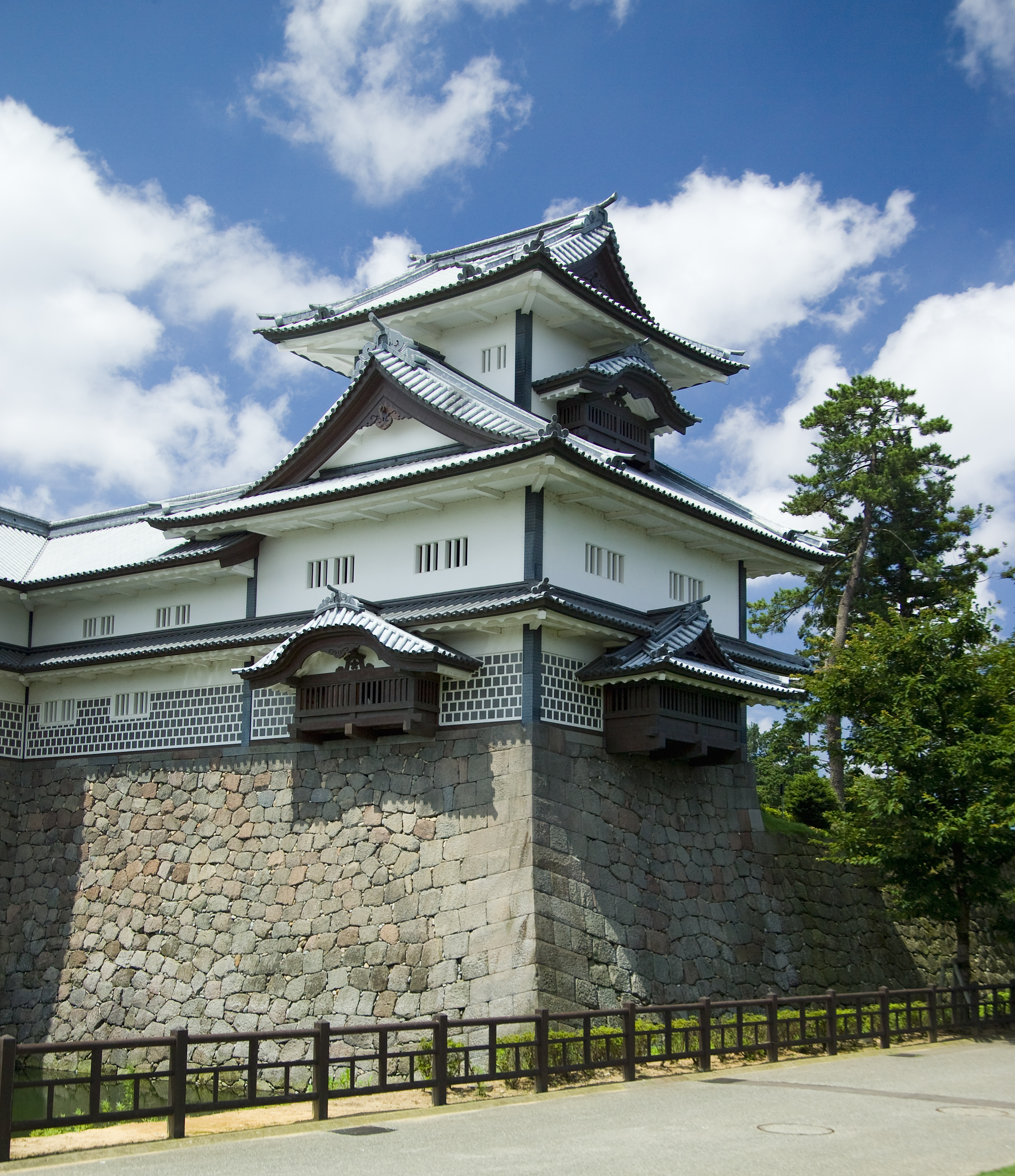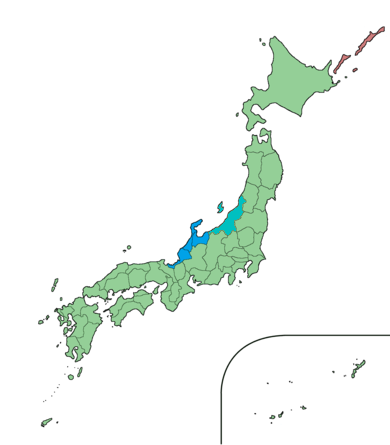|
Kanazawa
is the capital of Ishikawa Prefecture in central Japan. , the city had an estimated population of 466,029 in 203,271 households, and a population density of 990 persons per km2. The total area of the city was . Etymology The name "Kanazawa" (, ), which literally means "marsh of gold", is said to derive from the legend of the peasant Imohori Togoro (literally "Togoro Potato-digger"), who was digging for potatoes when flakes of gold washed up. The well in the grounds of Kenroku-en is known as to acknowledge these roots. The area where Kanazawa is was originally known as Ishiura, whose name is preserved at the Ishiura Shrine near Kenrokuen. The area around Kanazawa was part of ancient Kaga Province. History Muromachi period During the Muromachi period (1336 to 1573), as the power of the central shōguns in Kyoto was waning, Kaga Province came under the control of the Ikkō-ikki, followers of the teachings of priest Rennyo, of the sect, who displaced the official ... [...More Info...] [...Related Items...] OR: [Wikipedia] [Google] [Baidu] |
Ishikawa Prefecture
is a Prefectures of Japan, prefecture of Japan located in the Chūbu region of Honshu island. Ishikawa Prefecture has a population of 1,096,721 (1 January 2025) and has a geographic area of 4,186 Square kilometre, km2 (1,616 sq mi). Ishikawa Prefecture borders Toyama Prefecture to the east, Gifu Prefecture to the southeast, and Fukui Prefecture to the south. Kanazawa is the capital and largest city of Ishikawa Prefecture, with other major cities including Hakusan, Ishikawa, Hakusan, Komatsu, Ishikawa, Komatsu, and Kaga, Ishikawa, Kaga. Ishikawa is located on the Sea of Japan coast and features most of the Noto Peninsula which forms Toyama Bay, one of the largest bays in Japan. Ishikawa Prefecture is part of the historic Hokuriku region and formerly an important populated center that contained some of the wealthiest ''Han system, han'' (domains) of the History of Japan#Feudal Japan, Japanese feudal era. Ishikawa Prefecture is home to Kanazawa Castle, Kenroku-en one of the Three G ... [...More Info...] [...Related Items...] OR: [Wikipedia] [Google] [Baidu] |
Kanazawa Castle
is a large, partially restored Japanese castle in Kanazawa, Ishikawa, Japan. It is located adjacent to the celebrated Kenroku-en Garden, which once formed the castle's private outer garden. It was the headquarters of Kaga Domain, ruled by the Maeda clan for 14 generations from the Sengoku period until the coming of the Meiji Restoration in 1871. History During the late Muromachi period, the ''Ikkō-ikki'', followers of the teachings of priest Rennyo, of the Jōdo Shinshū sect, displaced the official governors of Kaga Province, the Togashi clan, and established a kind of theocratic republic later known as " The Peasants' Kingdom". Their principal stronghold was the Kanazawa Gobō, a fortified temple complex on the tip of the Kodatsuno Ridge. Backed by high hills and flanked on two sides by rivers, it was a natural fortress, around which a castle town developed. This was the start of what would become the city of Kanazawa. In 1580, Oda Nobunaga sent his general Sakuma Morimasa ... [...More Info...] [...Related Items...] OR: [Wikipedia] [Google] [Baidu] |
Kenroku-en
, located in Kanazawa, Ishikawa, Japan, is a strolling style garden constructed during the Edo period by the Maeda clan. Along with Kairaku-en and Kōraku-en, Kenroku-en is considered one of the Three Great Gardens of Japan and is noted for its beauty across all seasons, particularly in winter. Spread over nearly 25 acres, features of the landscape include meandering paths, a large pond, several tea houses, and one of Japan's oldest fountains. First opening to the public in 1871, the garden was later designated a National Site of Scenic Beauty in 1922, and subsequently received status as a National Site of Special Scenic Beauty in 1985. The grounds are open through paid admission year-round during daylight hours. History Kenroku-en was developed from the 1620s to the 1840s by the Maeda clan, the '' daimyōs'' (feudal lords) who ruled the former Kaga Domain. While the date of initial development of the garden that would become known as Kenrokuen is rather unclear, one ver ... [...More Info...] [...Related Items...] OR: [Wikipedia] [Google] [Baidu] |
21st Century Museum Of Contemporary Art, Kanazawa
The is a museum of contemporary art located in Kanazawa, Ishikawa, Japan. The museum was designed by Japanese architects Kazuyo Sejima and Ryue Nishizawa of the architectural office SANAA in 2004. In October 2005, one year after its opening, the Museum marked 1,570,000 visitors. In 2020, due to the COVID-19 pandemic it attracted only 971,256 visitors, a drop of 63 percent from 2019, but it still ranked tenth on the list of most-visited art museums in the world. Since its founding, the museum's director has been Yuko Hasegawa. The building The Museum is located in the center of Kanazawa, near Kenroku-en garden and the Ishikawa Prefectural Museum of Art. The building has a circular form, with a diameter of 112.5 metres. This shape aims to keep the appearance of the overall building volume low, to mitigate the scale of the project and allows access from multiple points of entry. The transparency of the building further manifests the wish to avoid the museum being perceive ... [...More Info...] [...Related Items...] OR: [Wikipedia] [Google] [Baidu] |
Chūbu Region
The , Central region, or is a region in the middle of Honshū, Japan's main island. In a wide, classical definition, it encompasses nine prefectures (''ken''): Aichi, Fukui, Gifu, Ishikawa, Nagano, Niigata, Shizuoka, Toyama, and Yamanashi. It is located directly between the Kantō region and the Kansai region and includes the major city of Nagoya as well as Pacific Ocean and Sea of Japan coastlines, extensive mountain resorts, and Mount Fuji. The region is the widest part of Honshū and the central part is characterized by high, rugged mountains. The Japanese Alps divide the country into the Pacific side, sunny in winter, and the Sea of Japan side, snowy in winter. Although Mie is part of Kinki/Kansai/Western Japan in traditional geographical regional divisions, Northern Mie is part of the metropolitan area around Nagoya, and Mie is in many practical contexts considered to be part of Tōkai/Chūbu/Central Japan. Including Mie, Chūbu had a population of 23,010 ... [...More Info...] [...Related Items...] OR: [Wikipedia] [Google] [Baidu] |
Kaga Ikki
The Kaga ''ikki'', also known as The Peasants' Kingdom, was a theocratic feudal confederacy that emerged in Kaga Province (present-day southern Ishikawa Prefecture), Japan, during the late 15th and early 16th centuries. The Kaga ''ikki'' was a faction of the Ikkō-ikki, a gathering of peasant farmers, monks, priests, and '' jizamurai'' (upper-ranking peasant warriors) that espoused belief in Jōdo Shinshū Buddhism. Though nominally under the authority of the head abbot of the Hongan-ji, the '' Monshu'', the ''ikkō-ikki'' proved difficult to control. During the Ōnin War, the ''ikki'' in Kaga, with the approval of the Monshu Rennyo, helped restore Togashi Masachika to the position of '' shugo'' (military governor). However, by 1474 the ''ikki'' fell into conflict with Masachika, and in late 1487, they launched the Kaga Rebellion. Masachika was overthrown, and Togashi Yasutaka, his uncle, took his place as ''shugo''. Under Yasutaka's son, Taneyasu, the Kaga ''ikki'' ass ... [...More Info...] [...Related Items...] OR: [Wikipedia] [Google] [Baidu] |
Hokuriku Region
The is located in the northwestern part of Honshu, the main island of Japan. It lies along the Sea of Japan and is part of the larger Chūbu region. It is almost equivalent to the former Koshi Province (Japan), Koshi Province and Hokurikudō area in pre-modern Japan. From the Heian period until the Edo period, the region was a core recipient of population, and grew to be proportionately much larger than it is today, despite the rural character; in modern times, its population has remained consistent, with most urban growth in the 20th century instead taking place in Kantō region, Kanto, Nagoya, Chūkyō, and Kansai region, Kansai. The Hokuriku region is also known for traditional culture that originated from elsewhere that has been long lost along the Taiheiyō Belt. The Hokuriku region includes the four prefectures of Ishikawa Prefecture, Ishikawa, Fukui Prefecture, Fukui, Niigata Prefecture, Niigata and Toyama Prefecture, Toyama, although Niigata is sometimes included as an a ... [...More Info...] [...Related Items...] OR: [Wikipedia] [Google] [Baidu] |
Core Cities Of Japan
A is a class or category of cities of Japan, Japanese cities. It is a local administrative division created by the national government.Web-Japan.org"Local self-government", p. 3 retrieved 2012-11-28. Core cities are delegated many functions normally carried out by Prefectures of Japan, prefectural governments, but not as many as Cities designated by government ordinance of Japan, designated cities. To become a candidate for core city status, a city must have a population greater than 300,000 and an area greater than 100 square kilometers, although special exceptions may be made by order of the cabinet for cities with populations under 300,000 but over 200,000. After the abolition of Special cities of Japan, special city status on April 1, 2015, any city with a population above 200,000 may apply for core city status. Application for designation is made by a city with the approval of both the city and prefectural assemblies. History The term "core city" was created by the first c ... [...More Info...] [...Related Items...] OR: [Wikipedia] [Google] [Baidu] |
Kaga Province
was a province of Japan in the area that is today the south and western portion of Ishikawa Prefecture in the Hokuriku region of Japan. Kaga bordered on Echizen, Etchū, Hida, and Noto Provinces. It was part of Hokurikudō Circuit. Its abbreviated form name was . History was an ancient province of Japan and is listed as one of the original provinces in the '' Nihon Shoki''. The region as a whole was sometimes referred to as . In 701 AD, per the reforms of the Taihō Code, Koshi was divided into three separate provinces: Echizen, Etchū, and Echigo. In 823 AD, the two eastern districts of Echizen Province (Kaga and Enuma) were separated to form Kaga Province. Kaga was thus the last province to be created under the ''ritsuryō'' system. The same year, the northern portion of Enuma District became Nomi District, and the southern portion on Kaga District became Ishikawa District. Kaga District itself was renamed Kahoku District. The provincial capital and provincia ... [...More Info...] [...Related Items...] OR: [Wikipedia] [Google] [Baidu] |
Prefectures Of Japan
Japan is divided into 47 prefectures (, , ), which rank immediately below the national government and form the country's first level of jurisdiction and Administrative divisions of Japan, administrative division. They include 43 prefectures proper (, ''Prefectures of Japan#Ken, ken''), two Fu (administrative division), urban prefectures (, ''Prefectures of Japan#Fu, fu'': Osaka Prefecture, Osaka and Kyoto Prefecture, Kyoto), one regional prefecture (, ''Prefectures of Japan#Dō, dō'': Hokkaido, Hokkaidō) and one metropolis (, ''Prefectures of Japan#To, to'': Tokyo). In 1868, the Meiji Restoration, Meiji ''Fuhanken sanchisei'' administration created the first prefectures (urban ''fu'' and rural ''ken'') to replace the urban and rural administrators (''bugyō'', ''daikan'', etc.) in the Tenryō, parts of the country previously controlled directly by the shogunate and a few territories of rebels/shogunate loyalists who had not submitted to the new government such as Aizu domain, ... [...More Info...] [...Related Items...] OR: [Wikipedia] [Google] [Baidu] |





